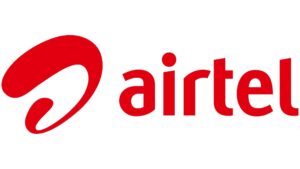
Bharti Airtel is one of the largest telecommunications companies in the world. Founded in 1995, the company offers a range of telecommunications services, namely, mobile phone, fixed-line telephone, fixed broadband, satellite and digital TV, IPTV, and internet television. The logo of Bharti Airtel has seen a few changes since the inception of the company.
The evolution of the Airtel logo is a reflection of the company’s growth, its ambition to connect with a global audience, and its adaptability to changing market dynamics. The article explores the various logo changes undertaken by Bharti Airtel, among other details about the company.
The Genesis of the Bharti Airtel Logo (1994 – 2002)
Airtel’s very first logo was introduced around 1994, and it featured a bold red slanted ellipse encasing the word “AIRTEL” in bold, black, uppercase, and using a font similar to Bureau Grot Wide Black. The typeface was strong and authoritative and was designed to convey the qualities of dynamism, leadership, and energy.
The logo also included a slogan, “touch tomorrow”, beneath the wordmark in two levels and colours (black and red) to emphasise clarity and a sense of forward movement. The second word, “tomorrow”, of the slogan was indented to the right in red to align with the red-coloured ellipse. This initial design set the tone for Airtel’s brand and established a presence that was both confident and approachable.

(1995 – 2010)
In 1995, Airtel updated its logo to what came to be known as the “flag logo”. This design featured alternating red and white blocks, with the brand name split into two parts. For instance, the first part, “Air”, appeared in black against a white background, while the second part, “Tel”, was rendered in white on a red background. The dot above the letter “i” was coloured red to symbolise innovation and attention to detail.
Over time, this logo became iconic in India and represented Airtel’s commitment to innovation and its growing leadership in the telecom industry. The modernist approach and the striking use of red and white helped the logo stand out in a crowded marketplace, while the red colour continued to symbolise energy and passion.

(2010 – Present)
A major shift in Airtel’s brand identity came in November 2010, when it unveiled a new logo and brand identity. Designed by The Brand Union (London) and JWT India, the new logo introduced a stylised, lowercase “a”, which became known as the “Airtel Wave”. The design brief called for a modern, vibrant, and friendly look, with all lowercase letters to signal accessibility and humility.
The curved “wave” symbol was crafted to be warm and inviting, and it represented a dynamic force and the brand’s promise of “no boundaries”. While the red colour, which was a part of Airtel’s heritage, was retained to express energy and passion, the new shape aimed for instant recognition across diverse international markets.

(2014 – Present)
The 2014 logo is in addition to the one created in 2010. It was similar to the previous logo, but with the addition of the motto “THE SMARTPHONE NETWORK” in red below and written using a grotesque typeface. The second word of the phrase “SMARTPHONE” was highlighted in bold. The brand name above was written using custom lowercase glyphs, and even higher was the iconic deformed spiral. Although the overall colour of the logo is red, it shows a tint that is similar to a light marsala.

The Elements of the Bharti Airtel Logo
Font
The wordmark of the Bharti Airtel logo uses one of the fonts of the Ubuntu family, especially the Medium category. Some of the letters have been shown differently. For instance, the lower right glyph of the letter “a” is missing, while the letters “l” and “t” do not have the lower ends of their glyphs extended. So, the wordmark appears to be in sync with the wave-like emblem.
Colour
The Bharti Airtel logo uses a red colour palette to symbolise energy, passion, and dynamism. The simple colour usage makes a stronger visual impact.
The History of Bharti Airtel
Bharti Mittal was founded by Sunil Bharti Mittal, and the roots of the company can be traced back to the early 1980s, when Mittal began assembling push-button phones in India. This innovation marked the beginning of Bharti Telecom Limited (BTL), which soon expanded to manufacturing fax machines and cordless phones. The company thus established itself as a pioneer in India’s nascent telecom equipment industry.
In 1992, Sunil Mittal successfully applied for one of the four mobile phone network licenses that were auctioned in India. It was a move that laid the foundation for the future of the company. To meet the licence requirements, Mittal partnered with the French telecom group Vivendi, and after getting an approval from the government, he launched cellular services in Delhi in 1995 under the brand name Airtel through Bharti Cellular Limited (BCL). This launch marked the beginning of India’s mobile revolution. Airtel quickly gained traction and became the first telecom company in the country to cross the two-million mobile subscriber mark.
During the period of the late 1990s and early 2000s, Bharti Airtel expanded rapidly by acquiring regional operators such as JT Holdings, Skycell Communications, and Spice Cell. It thus extended its footprint across Karnataka, Andhra Pradesh, Chennai, and Kolkata. In 2002, Bharti Airtel went public and listed its shares on the Bombay Stock Exchange and the National Stock Exchange of India. This helped the company get the much-needed capital for further expansion.
By 2005, Airtel had become India’s largest mobile operator and offered a pan-India network that covered all 23 telecom circles. The company also launched broadband and fixed-line services. It diversified its offerings and reached rural markets to ensure connectivity across the country. In the same year, Airtel introduced “Hello Tunes,” thereby becoming the first operator in India to offer caller ring tones. Its theme song was composed by A.R. Rahman, which achieved widespread popularity.
Airtel’s ambitions soon extended beyond India. In 2008, the company launched DTH (Direct-to-Home) services and explored a major acquisition of South Africa’s MTN Group, which did not materialise. In 2009, Airtel entered the Sri Lankan market, and in 2010, it made a landmark acquisition of Zain Africa BV. This way it expanded its operations to several African countries and established its status as a multinational telecom giant.
In 2011 and 2012, Airtel launched 3G and 4G services in India, respectively. The company continued to innovate and launched the Airtel Payments Bank in 2017. Thereafter, it rolled out Voice over LTE (VoLTE) and 5G services in subsequent years. Airtel’s unique business model, which involved outsourcing all operations except marketing, sales, and finance, allowed it to maintain low costs and high volumes. This strategy has since been emulated by other operators.
Today, Bharti Airtel operates in 18 countries across South Asia and Africa, as well as the Channel Islands. It offers a wide range of services, including mobile, broadband, fixed-line, and digital banking. It is recognised as the second-largest mobile network operator in both India and the world, and its commitment to innovation and connectivity continues to shape the telecommunications landscape.
Interesting Facts About Bharti Airtel
- Airtel operates in 18 countries across South Asia and Africa and serves over 500 million customers. This makes it one of the top three mobile operators in the world and the largest integrated communications solutions provider in India. In Africa, it is the second-largest mobile operator, which underscores its global reach and influence.
- The company has consistently been at the forefront of technological advancements. In 2022, Airtel launched 5G services in India, and in 2025, it partnered with Nokia and Ericsson to enhance its 5G core infrastructure and introduced cutting-edge Packet Core appliance solutions to boost 4G and 5G efficiency.
- Airtel is known for its rapid and customer-centric innovations. In April 2025, it partnered with Blinkit to launch a unique service that delivers SIM cards to customers within 10 minutes, which was a first in India. This plan is currently active in 16 cities with plans for further expansion.
- Airtel has played a key role in strengthening digital connectivity between continents. In March 2025, it brought the 2Africa Pearls undersea cable to Indian shores. This created stronger digital links between India, Africa, and Europe in partnership with center3 and Meta.
- The company’s financial performance has been impressive. For the quarter ending December 2024, Airtel reported a 19.14% increase in revenue and a staggering 550.27% jump in net profit compared to the same period the previous year.
- Airtel has received numerous awards and recognitions. It was named India’s second most valuable brand in the first-ever BrandZ ranking by Millward Brown and WPP plc. The company has also won the Golden Peacock Award for Sustainability and the Dun & Bradstreet Award for ESG excellence and has been recognised among India’s Best Workplaces for Women.
- The company is a pioneer in digital and entertainment services. Airtel Xstream, its OTT aggregator platform, reached 2 million paid subscribers in 2023, which made it India’s fastest-growing service in the category.
- Airtel has a history of firsts, which include the world’s first intercontinental roaming facility. According to this, the company offered free incoming calls for African businessmen and was the first operator to launch 4G services in the Andaman and Nicobar Islands.
- The company has also contributed to social and rural development. In 2024, Airtel partnered with the Indian Army to connect remote villages along the Line of Control in North Kashmir. This initiative advanced the cause of digital inclusion in challenging terrains.
- Airtel has set up the Satya Bharti School Programme as a key initiative to educate underprivileged children in rural India.
- Airtel’s leadership and innovation have been recognised globally. For example, Sunil Bharti Mittal, the founder and chairman of the company, received the Business Leader of the Year Award at The Economic Times Awards for Corporate Excellence in 2023.
Finally
The Bharti Airtel logo and its iterations are a testament to the journey of the company from a regional telecom operator to a global communications powerhouse. Each iteration of the logo has encapsulated Airtel’s aspirations. It showed how the brand first established its strong presence in India and then went about becoming a unifying brand across continents. The current “Airtel Wave” logo stands as a testament to the brand’s youthful, dynamic, and inclusive spirit. It ensures instant visual recognition in a competitive global marketplace.